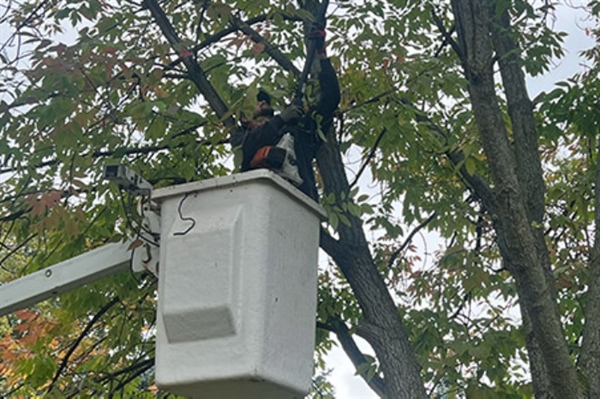How Often Should You Trim Your Trees? Essential Tips and Timing

Trees add personality, shade, and natural beauty to any landscape but need consistent care to stay healthy, safe, and visually appealing.
Determining the right time and frequency for trimming can be challenging, with factors like species, climate, and growth habits all playing a role.
Homeowners often wonder if they’re pruning too much, too little, or just right. Proper trimming enhances a tree’s appearance, boosts its lifespan, and reduces risks like falling branches.
At A-1 Curb Appeal, we’re dedicated to keeping your property and trees in peak condition.
Let’s break down the key factors to ensure your trees thrive and remain strong while adding value to your outdoor space.
What are the Signs that a Tree Needs Trimming?
Regular observation can help identify when a tree needs trimming. Dead branches, uneven growth, or branches too close to structures or power lines indicate that maintenance is needed.
If branches rub against each other, the tree may weaken over time, causing further issues.
Excessive growth at the crown, branches blocking sunlight from reaching lower parts, and diseased branches also indicate that trimming may be necessary.
Dead wood, indicated by brittle branches that snap easily, poses a higher risk and should be removed promptly.
Identifying these issues early can make a significant difference in maintaining a tree’s structure and strength.
How Does Trimming Improve Tree Health?
Trimming is vital to tree health. It removes dead or diseased branches, allowing healthy parts of the tree to receive more nutrients and sunlight.
By eliminating branches with diseases or insect infestations, you’re reducing the risk of those issues spreading to other parts of the tree or nearby plants.
Well-maintained trees have better airflow and sunlight exposure, which is crucial for healthy growth.
When sunlight penetrates the tree canopy effectively, it improves photosynthesis, leading to stronger limbs and leaves. This also helps reduce fungus growth, which thrives in dark, crowded areas.
Trimming also stimulates the growth of new, healthy branches, enhancing the tree’s vitality.
Can Trimming Prevent Overgrowth and Property Damage?
Unchecked tree growth can cause branches to interfere with nearby structures, such as roofs, gutters, and power lines.
Regular trimming controls growth, reducing the likelihood of branches causing damage during storms or high winds.
Trees with excessive growth can also develop weak limbs that may break, potentially causing injury or property damage.
Besides protecting property, trimming encourages more balanced growth, distributing weight evenly across branches.
It strengthens the tree’s structure, making it less susceptible to damage from severe weather.
By managing overgrowth, homeowners can prevent issues before they escalate, ensuring trees are a safe and beautiful part of the landscape.
Property owners seeking a long-term solution to tree maintenance will benefit from incorporating routine trimming into their care plans.
While trimming does not guarantee complete safety from damage, it significantly reduces the risk by proactively addressing vulnerable areas.
How Does Tree Type Affect Trimming Frequency?
Different trees have unique growth rates and structural needs, which impact how often they should be trimmed.
Fast-growing trees, like willows and poplars, may require more frequent trimming to prevent overgrowth, while slower-growing species, such as oaks, benefit from less frequent but careful pruning.
Evergreens, for instance, need minimal trimming as they maintain their shape naturally, while flowering trees may require trimming post-bloom to maintain their beauty and health.
Deciduous trees, which lose leaves seasonally, often benefit from trimming when dormant in late winter, encouraging stronger spring growth.
When Is the Best Season to Trim Trees?
Seasonal timing plays a significant role in the success of tree trimming. Most experts recommend late winter as an ideal time for trimming since trees are dormant, making them less susceptible to diseases and pests.
Trimming during dormancy promotes new growth in spring, as the tree has more energy to invest in healthier, stronger branches.
For flowering trees, trimming after they bloom preserves the health and appearance of blossoms.
Similarly, removing dead or diseased branches during summer can benefit the tree by reducing stress during the growing season. Avoid trimming in late fall, as cuts may not heal as quickly, increasing susceptibility to winter damage.
Seasonal trimming plans align with the tree’s natural growth cycle, supporting long-term health.
If planning tree maintenance, consult A-1 Curb Appeal for advice on timing, ensuring trees thrive year-round in harmony with seasonal changes.
Let A-1 Curb Appeal Keep Your Trees in Great Shape
At A-1 Curb Appeal, we understand the value trees bring to your property, from their aesthetic charm to the shade and serenity they provide.
Keeping your trees in great shape requires regular care, proper trimming, and an expert touch to ensure they remain healthy, safe, and visually appealing.
Our team of professionals is dedicated to providing premium tree and yard care tailored to your landscape’s unique needs.
Whether it’s routine pruning, hazard prevention, or enhancing your trees’ natural beauty, our expert team has the experience and tools to deliver exceptional results.
Let us help you preserve the strength and beauty of your trees for years to come. Contact us today.